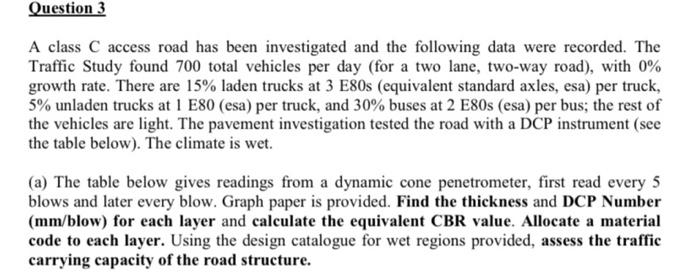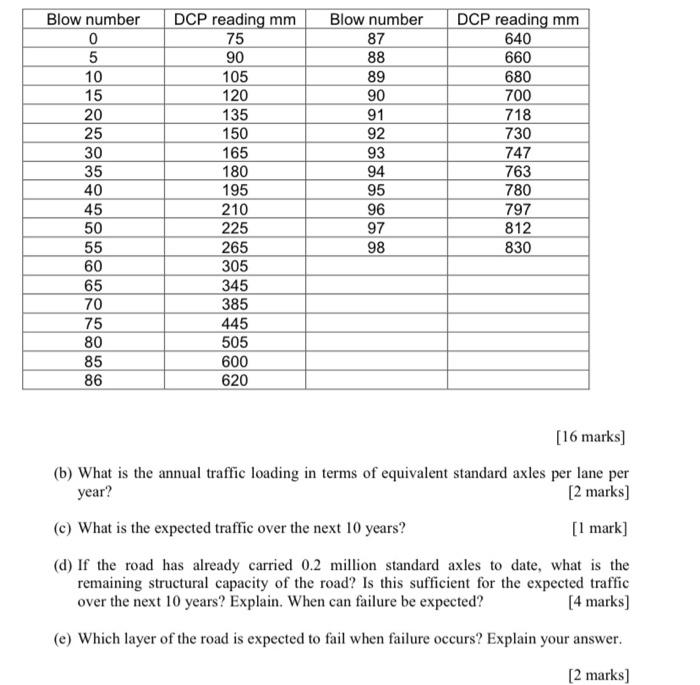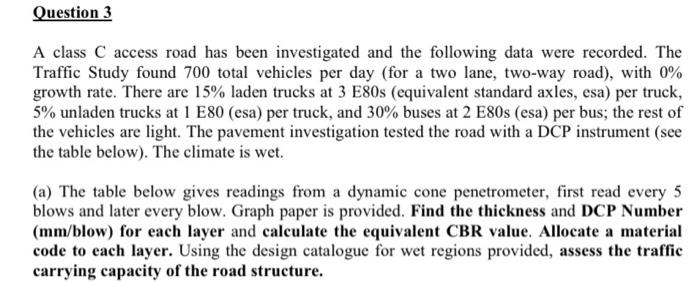A class C access road has been investigated and the following data were recorded. The traffic study found 700 total vehicles per day( for a two lane, two-way road), with 0% growth rate. There are 15% laden trucks at 3 E80s( equivalent standard axles, esa) per truck, 5% unladen trucks at 1 E80s(esa) per truck, and 30% buses at 2 E80s(esa) per bus; the rest of the vehicle are light. The pavement investigation tested the road with a DCP imstrument(see the table below). The climate is wet.
(a) The table below gives readings from a dynamic cone penetrometer, first tread every 5 blows and later every blow. Find the thickness and DCP Number(mm/blow) for each layer and calculate the equivalent CBR value. Allocate a material code to each layer. Using the design catalogue for wet regions provided, assess the traffic carrying capacity of the road structure.
Ouest A class access road has been investigated and the following data were recorded. The Traffic Staly Send 700 total vehicles per day for a two line, two-way rad) with powthre. There are 15% laden trucks at (equivalent standard axles, per track, mladen tricks at ESO esa per track and 30% buses 2 Estela) per the set of the vehicles light. The pavement investigation tested the road with a DCP intrumentice the table below). The climate is wat (A) The table below gives readings from a dynamic ce penetrometer, fast road every Now and liter every low. Graph paper is provided. Find the thickness and DCF Number (mm.blow) for each layer and calculate the equivalent CBR value Allocate a material code to each layer. Using the design catalogue for wet regions provided, assess the traffic carrying capacity of the road structure. Blow number 87 DCP reading 640 680 680 89 90 91 92 93 94 Blow number 0 5 10 15 20 25 30 35 40 45 50 55 60 65 70 75 80 85 86 DCP reading 75 90 105 120 135 150 165 180 195 210 225 265 305 345 385 445 505 600 620 88888888888 700 718 730 747 763 780 797 812 97 8:30 116 maria () What is the tal traffic loading in term of equivalent standard de perlane per 12 (c) What is the expected traffic over the next 10 yean? (d) If the road has already cumied 02 million standard axles to date. What is the reaningructural capacity of the road? Is this sufficient for the expected traffic over the next 10 years Explain. When can failure be upected! 14 marks! c) Which layer of the road is expected to fail when fue curs? Explain your answer Question 3 A class C access road has been investigated and the following data were recorded. The Traffic Study found 700 total vehicles per day (for a two lane, two-way road), with 0% growth rate. There are 15% laden trucks at 3 E80s (equivalent standard axles, esa) per truck, 5% unladen trucks at 1 E80 (esa) per truck, and 30% buses at 2 E80s (esa) per bus; the rest of the vehicles are light. The pavement investigation tested the road with a DCP instrument (see the table below). The climate is wet. (a) The table below gives readings from a dynamic cone penetrometer, first read every 5 blows and later every blow. Graph paper is provided. Find the thickness and DCP Number (mm/blow) for each layer and calculate the equivalent CBR value. Allocate a material code to each layer. Using the design catalogue for wet regions provided, assess the traffic carrying capacity of the road structure. Blow number 0 5 10 15 20 25 30 35 40 45 50 55 60 65 70 75 80 85 86 DCP reading mm 75 90 105 120 135 150 165 180 195 210 225 265 305 345 385 445 505 600 620 Blow number 87 88 89 90 91 92 93 94 95 96 97 98 DCP reading mm 640 660 680 700 718 730 747 763 780 797 812 830 [16 marks) (b) What is the annual traffic loading in terms of equivalent standard axles per lane per year? [2 marks] (c) What is the expected traffic over the next 10 years? [1 mark) (d) If the road has already carried 0.2 million standard axles to date, what is the remaining structural capacity of the road? Is this sufficient for the expected traffic over the next 10 years? Explain. When can failure be expected? [4 marks] (e) Which layer of the road is expected to fail when failure occurs? Explain your answer. [2 marks] EQUATIONS, FUNCTIONS, MISCELLANEOUS INFORMATION Equivalent CBR from DCP values: CBR = 401.8 (DCP Number) 1284 CBR values for various layers are given in the table below: Minimum CBR 80 Material Code G4 G5 G6 45 25 Layer Gravel base Subbase Subbase/ selected Selected Subgrade Subgrade Subgrade G7 G8 G9 G10 15 10 7 3 3 to 7 7 to 15 >15 Subgrade Design Table Design CBR 15 Subgrade Design Table Design CBR











